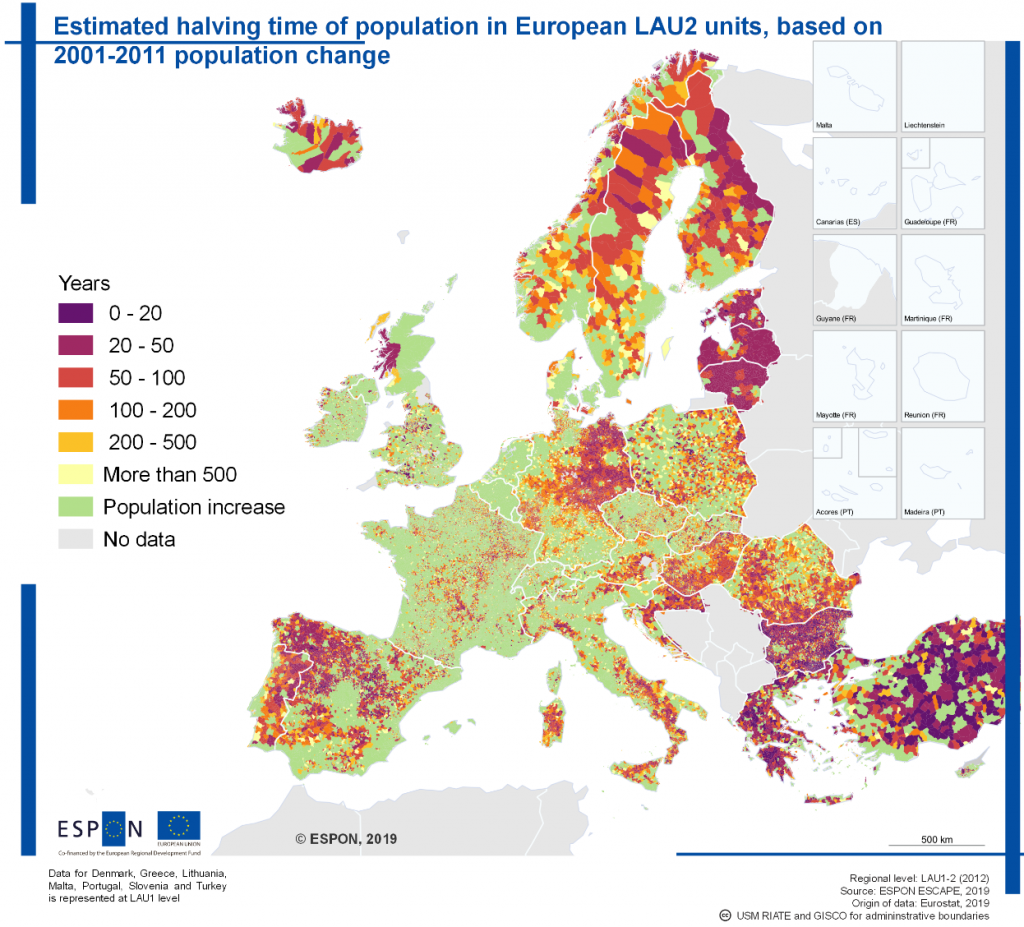Contributed by Andrew Copus

The James Hutton Institute is a partner in an EU-funded ESPON project about “shrinking” rural areas. The consortium is led by the University of Eastern Finland, with partners in Sweden, Austria, Spain and Hungary. We are a little over half way through this 18 month project, and have completed a range of initial tasks, together with Inception and Interim Reports. At the heart of the project are eight case studies of shrinking rural areas in Finland, Germany, Spain, Greece, Croatia, Hungary, Poland and Bulgaria.
One of the strongest impressions so far is of the diversity of shrinking rural areas in different contexts across Europe. Of course, there are common features; most obviously overall population trends, and ageing. However, digging a little deeper we find that there are many differences, in terms of chronology, the relative importance of migration and natural decrease, the drivers behind out-migration, current opportunities and potential, and longer-term prospects for the future.
Despite this variety, much of the academic literature, and policy thinking, seems to mostly reflect the twentieth century experience of Western European countries, – in which remoter rural areas are drained of the young and better educated, who migrate to cities for higher education, or to further their careers, leaving their birthplaces with unbalanced age structures, low fertility rates, high death rates and a dwindling working age population. This mechanism is often embedded in regional development assumptions about cities being the engines of growth, with rural areas dependent upon hypothesised “spread effects”. Such assumptions are important because they tend to condition the choice of solutions and policy interventions.
This Western European, and urban-driven, bias, is quite ironic, given the reality that, since at least the turn of the century, rural depopulation has been much more serious and widespread in the South and the East of Europe. Here the process of shrinking has often followed different paths. In the former socialist Member States of the East it has been associated with the transition from planned economies, and EU Accession, triggering international migration, which was often temporary, and involved low skilled workers as well as the better educated. In Mediterranean countries the push of reduced labour requirements as agri-business superseded traditional agriculture has been a key driver, and not so much the lure of urban industrialisation.
Here in Scotland it is hard not to notice the increasing attention paid to rural demography by the Scottish Government in recent years, cross-referencing both to the discourse on access to land, and to the focus upon inclusive growth within the National Performance Framework. With a wider perspective, it is very interesting to see that it is also rising up the agenda in EU circles, (including the Commission and the Committee of the Regions). The creation of the RUMRA (Rural, Mountainous and Remote Areas) Interservice Group perhaps reflects a shift in the composition of the European Parliament after the elections of May 2019. Publication of ESPON ESCAPE’s final report in the autumn will be timely. It presents an opportunity to reconsider some of the assumptions of the academic and grey literature, and to explore, in a pragmatic, evidence-based way, the implications for policy intervention logics.
For example, there are a whole set of assumptions about the precise objective of interventions to counter negative population trends. For instance, in the context of long-established shrinking, driven more by age structure than by current migration, is it realistic to talk about “growth”? Would the required scale of in-migration be acceptable to the local community? If, as in the recent draft National Island Plan, terms such as “healthy, balanced population profile” are preferred, how are these defined in practice? If they imply something short of reversing the population trend, is there a role for policies which help communities to adapt to demographic decline? If so, can the objective be articulated in terms of the well-being of the remaining population?
Digging deeper, along with clarification of demographic objectives goes the need to be explicit about motivations for policy approaches to service provision, both public and private, which have a very substantial role in driving, or responding to, rural population trends. For many years now neo-liberal and new public management principles have held sway in the UK, and across much of Europe. Economies of scale and cost-effectiveness have been primary considerations. More recently a rights-based perspective has entered the discourse. For example, Scotland’s National Islands Plan states, very clearly, that “every member of society has a right to live with dignity and to enjoy high quality public services wherever they live.” This principle can be traced back to the importance of inclusion in the National Performance Framework. Elsewhere, especially in the Nordic countries the principle of “territorial equivalence” (that you should not receive a lower level of services just because of where you live) has been influential for much longer.
Thirdly, there are a range of questions which relate, in one way or another, to the geographic scale of intervention. We need to think carefully about the assumption that local communities know best how to respond to population decline. Uncoordinated place-based interventions may have drawbacks. We know that the vast majority of changes of address are short-distance relocations, either associated with moves up the property ladder, or with stages of the family life cycle. The main result of local incentives to migrate into shrinking rural areas would likely be the diversion of some of these short-distance moves, resulting in what the regional policy evaluation literature would term “displacement” over boundaries, and (from a regional or national perspective) a “zero-sum game”. Perhaps a national spatial strategy could ameliorate this effect. Furthermore, in the context of the national demographic decline which Scotland is facing, perhaps we should be looking to recruit migrants from outside Scotland (or outside the UK)? On the other hand, the capacity and readiness of remote rural communities to fully embrace the consequences of globalisation are important considerations, with which an emphasis upon self-reliant community-based development perhaps sits less comfortably.
Finally, it is important to keep in mind the way in which terminology which was originally intended to be neutral becomes normative, or “loaded” with either positive or negative connotations. The term “shrinking” is a classic example. Already it is perceived by many as a negative label, which has potential to offend. Perversely, in the light of the current interest of the policy community, we need to beware that it does not become a “badge of honour”, in much the same way as GDP per capita became the key which unlocked EU Cohesion Policy funding. These are some of the issues which the ESPON ESCAPE research team seeks to address from a Europe-wide perspective. All of them, however, have considerable resonance in the Scottish context too.
